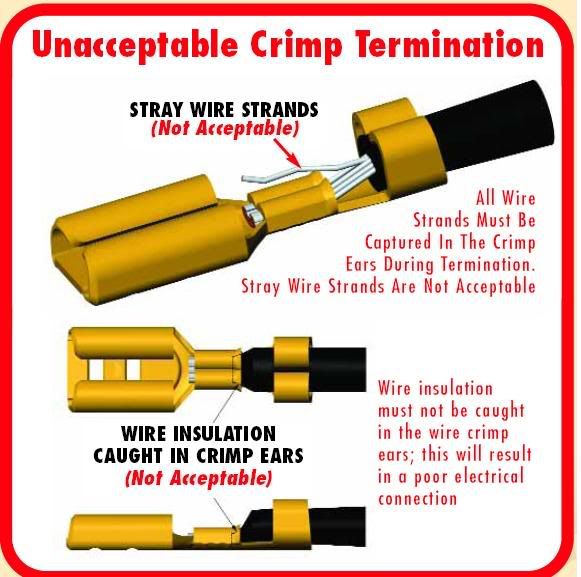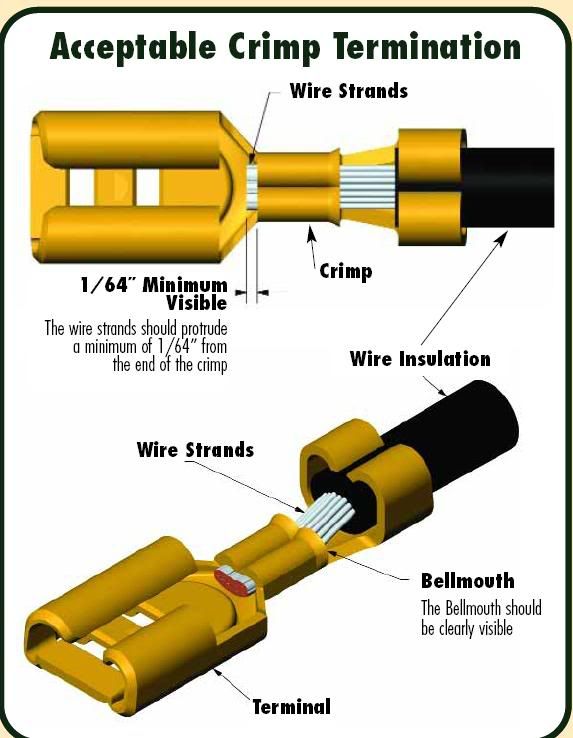Crimp Good/Crimp Bad


BMW Bikers of Metropolitan Washington Message Boards
https://bmwbmw.org/forums/


R4R&R wrote:Personally, I like to 'tin' my wires before crimping them. This usually eliminatesstary strands.
R4R&R wrote:Personally, I like to 'tin' my wires before crimping them. This usually eliminatesstary strands.
Ted wrote:What about a bead of solder after the crimp is done?
jskene wrote:A solderless crimp is better than a soldered, uncrimped joint because the heat generated by high current through the connection can melt solder, resulting in a failed joint.
It's best to use a ratchet style crimper, never the combination crimper/wire cutter, if you want a reliable joint.

echo wrote:PS If you tin the wires before crimping they pull out of the crimp on the machine much easier.
R4R&R wrote:echo wrote:PS If you tin the wires before crimping they pull out of the crimp on the machine much easier.
Personally, I've never had a tinned, crimped wire connector come undone. My previous bike seemed to have 'issues' with some of the OEM crimps in the rear tail section of the harness. This seemed to affect the brake light, tail light, and turn signals. Vibrations from the engine (only speculation) seemed to cause the wires to break just outside of the crimps (from vibrations?). I replaced them quite a few times, and the final time I tinned the wires before crimping. That last fix lasted the remainder of the bike's life for me (over 15k miles). The previous standard crimps lasted between 7k and 10k miles before failing.
My current bike has over 60,000 miles and I've added an accessory fuse panel with tinned wires/crimps supplying the power for my accessories (GPS, iPod, Sirius radio). They've been on at least 45,000 of those miles. No failures (yet). If solder causes higher resistance, my connections aren't causing anymore than what's used on the PC board that's inside the car lighter adapter.
I have a question about tinned wires/higher resistance/more heat: Would this be the case regarding low power lighting (brake/turn signal)? I'm getting ready to re-wire my trailer and was planning on tinning/soldering the connections and sealing with heat-shrink. The crimps that came on the trailer when it was originally built are failing. No, they weren't tinned.
I'm not trying to say tinned and crimped connections are better, I'm only saying that they have been very reliable for me. No, I don't work for NASA, nor am I leaving our atmosphere anytime soon so the risks I'm taking are acceptable. I wonder how much NASA spent on testing different ways of crimping to find the best solution for their use?
BchrisL wrote:jskene wrote:A solderless crimp is better than a soldered, uncrimped joint because the heat generated by high current through the connection can melt solder, resulting in a failed joint.
It's best to use a ratchet style crimper, never the combination crimper/wire cutter, if you want a reliable joint.
+1 ( the ratchet style is expensive though, but it will "git 'er done" right.
echo wrote:NASA/military doesnt want flux on the solder connections. They have VERY high cleanliness standards for circuit boards. Why? Corrosion over decades of use. So they make us clean everything in a high pressure soponifier solution in a special machine. The high pressure solution can get into sealed parts and ruin them! And the thing is, its only old fashioned acid fluxes that corrode things. Rosin fluxes if reasonably cleaned wont hurt a thing. Ah but it gets deeper! Acid fluxes actually give a better solder joint than rosin fluxes! Acid flux is easily washed away with low pressure soap and water! So theres NO CHANCE of it getting into sealed parts! I know this because I work on a bench every day for 30 years soldering things. But...the ding dong people who sit behind a desk all their lives and write the specs dont have a clue. They make us use rosin flux (which wont hurt a thing) make us wash the boards in a high pressure cleaning machine (which can ruin the parts) which produces an inferior (but adequate) solder joint!